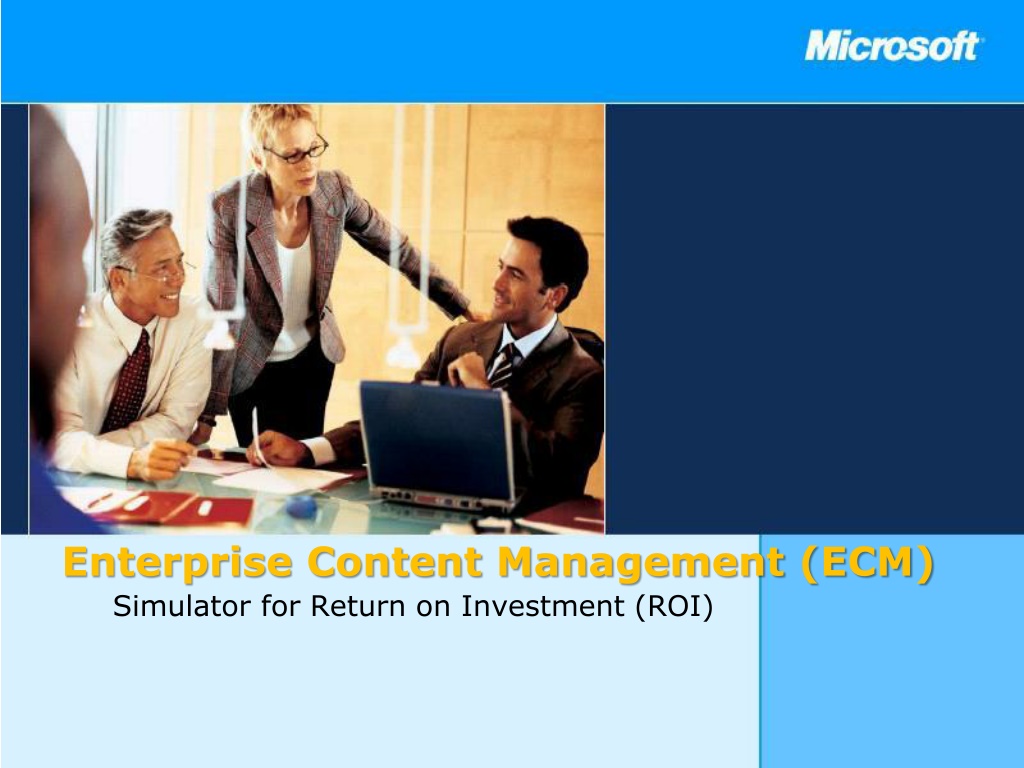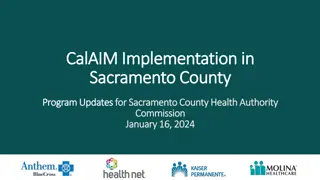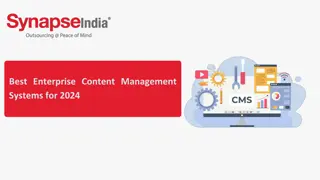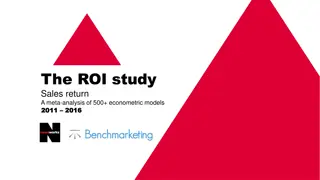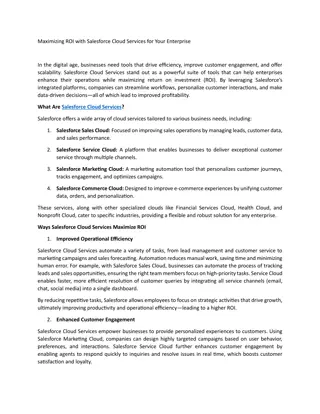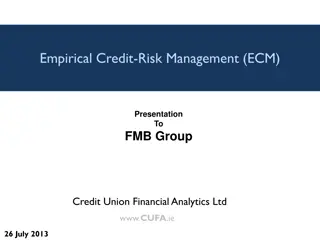Enterprise Content Management (ECM) ROI Simulator: Maximizing Investment Returns
Dive into the world of Enterprise Content Management (ECM) with the ROI simulator, a tool designed to help IT managers justify their investments in ECM infrastructure. Discover the key benefits, input and output processes, and a detailed walk-through of the simulator. Learn how to analyze financial metrics, assess benefits and costs, manage solution risks, and gather essential customer information for a comprehensive business assessment.
Download Presentation

Please find below an Image/Link to download the presentation.
The content on the website is provided AS IS for your information and personal use only. It may not be sold, licensed, or shared on other websites without obtaining consent from the author. Download presentation by click this link. If you encounter any issues during the download, it is possible that the publisher has removed the file from their server.
E N D
Presentation Transcript
Enterprise Content Management (ECM) Simulator for Return on Investment (ROI)
Objective of ECM ROI Simulator Help IT managers build a solid economic justification for a Enterprise Content Management infrastructure investment.
Key Benefits of ECM ROI Simulator Fast Results Less than 10 hours to complete a high-level Rapid Economic Justification (REJ) Easy to Use Just follow the worksheets from left to right Select which components of the ECM Solution to include Start with default data Alignment Analysis Impact of solution to Key Performance Indicators (KPIs) Financial Results
REJ Overview Economic Justification Process based on the Microsoft REJ Guide Download REJ guide: www.microsoft.com/value Document Management Records Management ECM Solution Components Web Content Management
Input and Output INPUT 1 Increase Revenue or Decrease Costs through Improved Document Management Enter Business Assessment Data into Pre-specified Fields 2 General company information: (e.g., Annual Revenue) Information on processes involved: (e.g., number of days to web content development request) Decrease Costs through Improved Records Management ECM Driven Process Improvements 3 Decrease Costs through Improved Web Content Management OUTPUT Translate process improvements into: Business-Level Metric Improvements KPI Improvements Financial Metrics Improvements Draft of Business Case Output in XPS 5
ECM ROI Simulator Walk-Through 6
Business Assessment Financial Metrics Business Assessment Benefit & Cost Solution Risk Customer Information 7
Business Assessment Collect general information regarding the customer organization (e.g., name, annual revenue, number of Information Workers, etc.) Also gather specific current state inputs for Document Management, Records Management, and/or Web Content Management practices, as applicable. Business Assessment Screenshot 8
Business Assessment Input Description Document Management- Required Inputs Input Comments Number of "Primary" Documents Produced per Year Throughout the simulator, ECM benefits from Document Management are driven by an estimated increase in the number of primary documents created per year, or a decrease in costs associated with primary document development. Primary documents are defined as major collaborative documents such as sales proposals, pitchbooks, magazine issues, etc. that directly impact a company s annual revenue. The default value is 500 primary document per year. Please Select Whether to Calculate Benefits Based on Increases in Revenue or Decreases in Costs Benefit calculations for Document Management are based on either increasing revenue or decreasing costs to avoid double counting. For example, Government or Non-Profit organizations may wish to calculate benefits based on cost savings, rather than revenue increase. Default value is Revenue. Percent of Annual Revenue Driven by "Primary" Document Development To ensure that the impact of primary document creation is not overstated, this input is used to set the contribution of each primary document to annual revenue. The default value is 10%. Average Number of IWs on a Primary Document Development Team Number of IWs in a document development team for a given primary document, which is used to drive cost savings calculations. Default value is 10. Percent of Team Member Time Solely Focused on Primary Document Development For cost based benefits, estimate the percent of team member time solely focused on document development when assigned to a primary document development team, as opposed to time dedicated to other concurrent activities or assignments. Default is 50%.
Business Assessment Input Description (cont.) Records Management Required Inputs Input Comments Current Annual Records Management Expenditures (both In-House and Third Party) (in Millions) Estimate of both in-house and 3rd party annual records management expenditures. The default is $5.0 Million, or 1% of annual revenue. Estimated Annual (Current or Potential) Legal Costs Associated with Inadvertent Destruction of Records Under Legal Hold, Inability to Produce Records during Discovery, Improper Retention of Emails, etc. (in Millions) Estimate the legal costs associated with record management problems using data from a previous year or estimating the potential impact for a future year. The default is $2.5 Million, or 0.5% of annual revenue.
Business Assessment Input Description (cont.) Web Content Management Required Inputs Input Comments Current Number of Web Content Development Requests Handled by IT Resources per Year Estimated number of web content development requests sent to IT or an IT Resource per year. Default is ten web content development requests per IW per year. Current Annual IT-Resource Web Content Management Expenditures (both In- House and Third Party) (in Millions) Estimate of both in-house and 3rd party annual web content management expenditures. The default is $5.0 Million, or 1% of annual revenue.
Solution Financial Metrics Business Assessment Benefit & Cost Solution Risk Solution Definition based on ECM Component(s) 12
Solution Identify key business process improvements driven by ECM Solution Components Map opportunities for improvement with ECM technologies 13
Solution (cont.) Each ECM Solution Component tab includes a description of the features and benefits of the component, as well as an input table: Process Step Current Business Process Issue Business Process Improvement Benefit Current Process Cycle Days Future Process Cycle Days Describes general business process steps for component solution Description of business process before implementation of ECM solution Highlights the issues or problems of the current business process Describes the future business process enabled by ECM technologies Highlights the benefits of the ECM-enabled process solution Customer input for the current number of processing days required to complete the process step Customer input for the future number of processing days required to complete the process step The difference between current cycle days and future cycle days drives calculated benefits and financial impacts throughout the simulator
Benefit / Cost Financial Metrics Business Assessment Benefit & Cost Solution Risk 15
DM: Increasing the Number of Primary Documents per Year Will Increase Revenue The company currently develops 500 primary documents per year (e.g., Sales Proposals, Pitchbooks, Magazine Editions, etc.) Using Microsoft ECM technologies, the company can streamline its document generation processes and respond faster to competitive opportunities Through streamlined document generation with the ECM technologies, the company can increase the number of primary documents it creates each year from 500 to 774 Primary document creation generates roughly 10% of the company s annual revenue $500M annual revenue x 10% of Annual Revenue Driven by primary document development / 500 proposals per year = $100,000 revenue per proposal 274 additional primary documents per year x $100,000 per additional document = $27,400,000 additional revenue generated through ECM enabled Document Management $27,400,000 additional revenue generated through ECM enabled Document Management x 25% contribution (profit) = $6,850,000 additional profit per year 16
DM (cont.): Improving Document Management will Decrease Development Costs The company currently develops 500 primary documents per year (e.g., Sales Proposals, Pitchbooks, Magazine Editions, etc.) The company currently develops primary documents in 10-person teams, with team members dedicating roughly 50% of their time to primary document development and 50% of their time to other, non-document development related tasks 500 primary documents x 10 IWs per team x 50% of team member time x 25 current cycle days to develop primary document x 8 work hours in a day = 500,000 current hours dedicated to primary document development per year Using Microsoft ECM technologies, the company can streamline its document generation processes from 25 cycle days to 15.5 cycle days (35%), reducing its document development costs A 35% reduction in document development cycle days = 170,000 hours 170,000 hours x $76,000 annual IW burdened salary / 2080 hours in a year = $6.2 million in savings per year with ECM enabled Document Management 17
RM: Improving Records Management will Decrease In-House and 3rd Party Costs and Legal Risk The company currently dedicates $5.0 million in annual Records Management expenditures (both in-house and third party) Additionally, the was liable for $2.5 million in legal costs associated with inadvertent destruction of records under legal hold, inability to produce records during discovery, and improper retention of emails last year Using Microsoft ECM technologies, the company can decrease its per record management expenditures and significantly decrease its legal risk related to records management Through increased records management efficiency with the ECM technologies, the company decrease the number of processing cycle days per record by 65%, from 19 to 6.5 days Additionally, through improved records management with the ECM technologies, the company can reduce its records management related legal costs and risk by 50% 65% reduction in cycle days per record x $5.0M current records management expenditures = $3.3M reduction in in-house and 3rd party records management costs through ECM enabled Records Management 50% reduction legal costs x $2.5M current legal expenses = $1.3M reduction in legal costs through ECM enabled Records Management 18
WCM: Improving Records Management will Decrease In-House and 3rd Party Costs The company s IT resources currently receive 50,000 web content development requests per year with web content management expenditures of $5.0 million per year $5.0M web content management expenditures / 50,000 requests per year = $100 per request expenditure Using Microsoft ECM technologies, IWs will be able to develop desired web content without IT resource support, decreasing web content development expenditures and increasing the efficiency of web content management Through streamlined web content management efficiency with the ECM technologies, the company decrease the number of development and management cycle days for web content by 83%, from 15 to 2.5 days 83% reduction in web content management cycle days x $5.0M current web content management expenditures = $4.2M reduction in in-house and 3rd party web content management costs through ECM enabled Web Content Management 19
Implementation Costs Implementation Costs: Reviews the potential software licensing, hardware improvement, training, and deployment costs associated with the selected ECM solution.
Risk Financial Metrics Business Assessment Benefit & Cost Solution Risk 21
Risk Highlight a number of technical implementation/deployment risks identified in the Microsoft REJ model for customer consideration The tab is for informational purposes only, and does not include any customer inputs or calculations 22
Financial Metrics Financial Metrics Business Assessment Benefit & Cost Solution Risk 23
Financial Metrics Translate Business-Level Improvements (from Benefit tab) into KPI Improvements and company-wide Revenue increases or cost decreases 24
Build a Value Proposition Most Likely Annual Solution Benefits Value Proposition 25
